Demodecosis is called quite common in animals. disease caused by a small skin parasite – a tick demodex. It lives in the upper layers of the skin, hair follicles and fat, sweat glands. At the initial stage of development, the disease practically does not manifest itself in any way, but over time, defeat becoming more extensive and tangible. Progressive Demodecosis in dogs affects not only the skin, but also all internal organs that leads to the death of the pet. There are several hundred varieties of such ticks, but the most dangerous of them is the species Demodex canis.
Content
- 1 Types and stages
- 2 Causes of Dog Infection
- 3 Symptoms
- 4 Diagnostics
- 5 What is dangerous demodicosis and how it is transmitted
- 6 Treatment
- 7 Disease Prevention
Types and stages
Contents
Of the huge variety of ticks that cause demodicosis, the most common are Demodex mange, injai, canis. These are very small, vermiform parasites, with many limbs and a developed jaw. Getting on the dog’s skin the tick makes its way to the hair follicle and with the help of the jaw apparatus, gnaws its way into the sebaceous gland.
It is important to remember that the entire life cycle of a parasite insect includes three stages: larva, nymph and adult (adult) and flows strictly in the same place. That is why in one the follicle can simultaneously be up to 200 or more adults ticks.
Clinical studies have shown that these parasites can live inside the skin of completely healthy animals, but in very small quantities. As soon as the dog gets sick and she has the protective functions of the body are reduced, then the ticks are activated, causing the development of demodicosis.
There are 4 main types of disease:
- juvenile;
- localized;
- pustular;
- generalized.
The easiest and most non-hazardous, considered localized (focal) demodicosis. It appears in the form of small lesions, about 2-3 cm in diameter, and their maximum number on the body does not exceed 4-5 plots. Most often, such foci are localized on the head, abdomen and dog’s breasts. The hair falls out on them, and the skin turns red, flaky and sore. Subject to the absolute health of the dog in most cases, such demodicosis goes away by yourself.
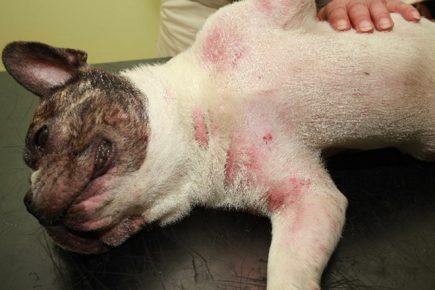
With the slightest decrease in immunity, the disease recurs and degenerates into generalized form
Generalized demodicosis affects most of the skin animal, affected areas acquire a gray-red tint and pungent odor. With the further development of tick disease penetrate into the body and affect the internal organs. Cure the generalized form is not always successful, because parasites are very multiply rapidly, destroying the liver and stomach, killing immunity.

This condition often ends with the death of the dog.
Juvenile refers to a special group of demodicosis and affects mainly the skin area around the eyes and paws of the dog. Interesting, that only puppies and young people suffer from a juvenile disease animals (up to a year). If such a lesion is found, it is necessary urgently start appropriate therapy.
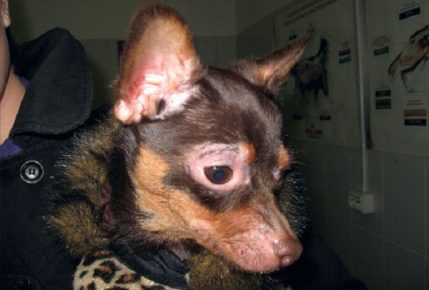
It is sometimes called ocular demodicosis, and the treatment is a little different from standard
Pustular demodicosis is characterized by the development of pustular rashes accompanied by severe itching, inflammation and pain. AT further illness can lead to sepsis, blood poisoning, or grows into a generalized form.
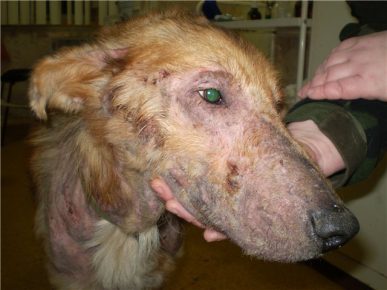
With untimely treatment, the disease can lead to dangerous the consequences
The so-called demodecosis of the ears is slightly less common in dogs. (otodemodecosis). It affects the outer part of the ear on which dark growths appear, accompanied by severe burning and scabies.
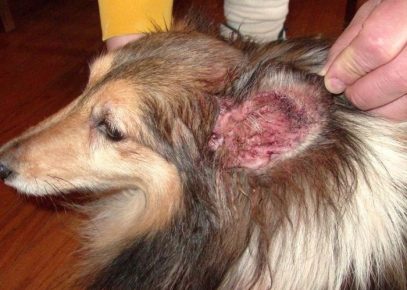
Otodemodecosis is the rarest form of the disease
Causes of Dog Infection

It is important to monitor the immunity of the dog in order to avoid various diseases
Healthy dogs with strong immunity are not affected. demodicosis, but with serious illnesses, exhaustion, poor nutrition and inadequate hygiene, the disease is rapidly developing.
To provide the dog with good nutrition, you must choose between finished feed and naturalka. This will help you articlehttps: //kot-pes.com/chto-luchshe-korm-ili-naturalka-dlya-sobak/
The main causes of the disease are:
- low immunity;
- oncological diseases;
- hormonal disorders;
- age;
- direct contact with an infected animal;
- long-term antibiotic treatment;
- heredity.
Juvenile demodicosis develops amid rising levels the hormone oxytocin produced by a nursing female immediately after childbirth. At the same time, demodexes quickly move from a sick dog to small puppies, causing the development of the initial stage of demodicosis. Ticks breed well in moist, humid areas, and the disease is often accompanied by conjunctivitis, scabies, stomatitis.
The risk group for potential infection includes the following breeds:
- German Shepherd;
- pug;
- bulldog;
- West Highland Terrier;
- sharpei;
- scotch terrier;
- rottweiler.
The most dangerous seasons for the occurrence of demodicosis is considered summer and spring. In most cases, the elderly suffer from ticks dogs and puppies.
If you want to know more about a breed like a pug, we advise you to read articlehttps: //kot-pes.com/sobaka-mops-foto-laskovyj-nrav-i-zhizneradostnost/
Symptoms

If the dog is constantly itching, it is urgent to contact to the veterinarian
At an early stage of pustular demodicosis, in a dog constant severe skin itching is noted, and a little later in places inflammation, slight redness appears. In a few days small watery vesicles form in the inflamed areas filled with a dark brownish liquid. After a few more days, the bubbles begin to burst, the hair falls out, and from liquid formed with very unpleasant wounds smell.
For a localized type of disease, the presence of 4–5 is characteristic lesion sites not prone to further growth. Often in severe demodicosis, the dog’s skin is completely covered dry scales, hair falls out, pus is secreted. Animal refuses food, becomes lethargic, body temperature abruptly declining.
With a generalized form in a dog, there are:
- vomiting
- increased salivation;
- cramps
- foam from the mouth;
- lack of coordination;
- weakness;
- dyspepsia.
With untimely treatment, the disease affects the internal organs and ends in death.
Diagnostics
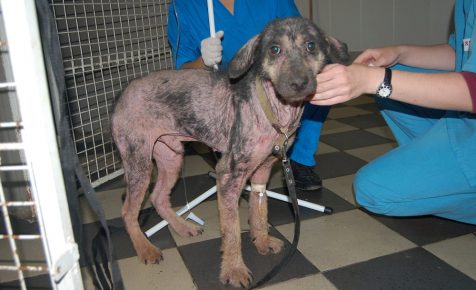
The veterinarian also evaluates the overall clinical picture of the disease, animal condition
It is not possible to independently determine whether a dog has demodexes will work out. To do this, contact qualified specialist who will conduct a full examination of the animal. The main diagnostic measures are tests for hereditary predisposition and scraping with skin.
The most informative analysis can be called deep scraping, in which the skin of the dog is plucked, squeezed and special the upper layer of the epithelium is scraped off with a tool until blood. This method allows you to identify 1-2 ticks, even in completely healthy animals. In infected dogs, this indicator will be measured in several tens.
To correctly diagnose, it is necessary to differentiate demodicosis from other similar diseases with similar symptoms. For example, dermatosis, furunculosis, mycosis and pyoderma have a similar symptoms and course. Sometimes (in the most severe cases) it can require a biopsy of the skin.
What is dangerous demodicosis and how it is transmitted

Before you start breeding dogs, you must spend thorough examination of the body of the expectant mother
The danger of demodicosis and its transmission may be different, it depends on several factors. Firstly, even completely a healthy dog may carry a small amount ticks that can be transmitted to others, weakened and depleted to animals. Secondly, in 100% of cases, the infection comes from the patient mothers to offspring.
It is important to remember that the slightest disturbances in the diet, any diseases that lead to a decrease in immunity can provoke the development of demodicosis. With close contact of dogs, local fever leading to infection.
Many dog owners are worried about how dangerous these ticks are for humans. This type of parasite does not live on human skin, and no danger to people represents. Man can only become a carrier diseases from one dog to another, but from demodicosis itself is not will suffer.
Treatment

The vet will help you choose a special shampoo that will help relieve symptoms
Try to cure your pet yourself with folk remedies will not work. If u use various herbal infusions and decoctions, then only in complex therapy in conjunction with drugs. The course of treatment and its the duration is determined by the veterinarian on the basis of previously diagnosed.
The first thing that a specialist will prescribe is bathing the dog with using antibacterial shampoo and skin treatment special ointment with antiseptic effect. With uncomplicated the localized form of this is enough for a complete cure. During treatment, you will have to take the pet to the clinic weekly, to do a control scraping.
In advanced cases, a long complex treatment involving antibiotics (for killing staphylococcus). In addition, the veterinarian may prescribe intramuscular the introduction of Immunoparasitane every 4 days for 1.5 months. After which is used by intravenous injection of Amitrazin or Ivomek. At the same time, the dog is given hepatoprotectors to protect the liver and vitamins. Additionally recommend using outdoor products such as Stronhold, sea buckthorn oil with the addition of liquid vitamin A.
Effectively help cope with ointment disease: sulfuric, ichthyol, Vetabiol. They are applied under a bandage, strictly observing dosage prescribed by your doctor. It is enough to apply sulfuric ointment on affected areas 1 time in two days, and the ichthyol should be smeared animal every 9-10 hours.
Good results can be achieved with drops at the withers. Lawyer who apply monthly for 16 weeks.
The fastest drug in the treatment of demodicosis considered Amitraz. The required amount of product is diluted in water and bathe a pre-trimmed dog. Such a procedure spend every 2 weeks, up to 6 treatments.
Ivermectin and Mibemycin tablets have proven themselves well.
Along with medication, you can use some folk remedies: a decoction of wormwood and honey, homemade ointment from celandine, decoction of St. John’s wort. During treatment, the dog’s nutrition should be dietary with all the necessary vitamins and minerals.
Disease prevention

Demodecosis vaccination is carried out with the drug Immunoparasitan
It is very difficult to cure demodicosis, because it requires a long therapy and continuous monitoring of the animal.
Therefore, it is better to take the necessary measures to avoid this. diseases:
- provide a complete, balanced diet, including yourself all the necessary complex of vitamins;
- exclude contact of the dog with stray animals;
- observe hygiene measures;
- thoroughly examine the animal regularly, especially before viscous.
Do not uncontrollably give the dog hormonal and antibacterial drugs that can cause a persistent decline immunity.
The most effective and effective method of protecting an animal is vaccination.
Demodecosis is a very serious and dangerous disease that requires long-term comprehensive treatment. Therapy is carried out at home conditions, but under the constant supervision of a veterinarian. Self-medication You can’t deal with such a disease, so as not to cause more serious consequences. For humans, demodicosis is not a danger represents and is transmitted exclusively among dogs.






